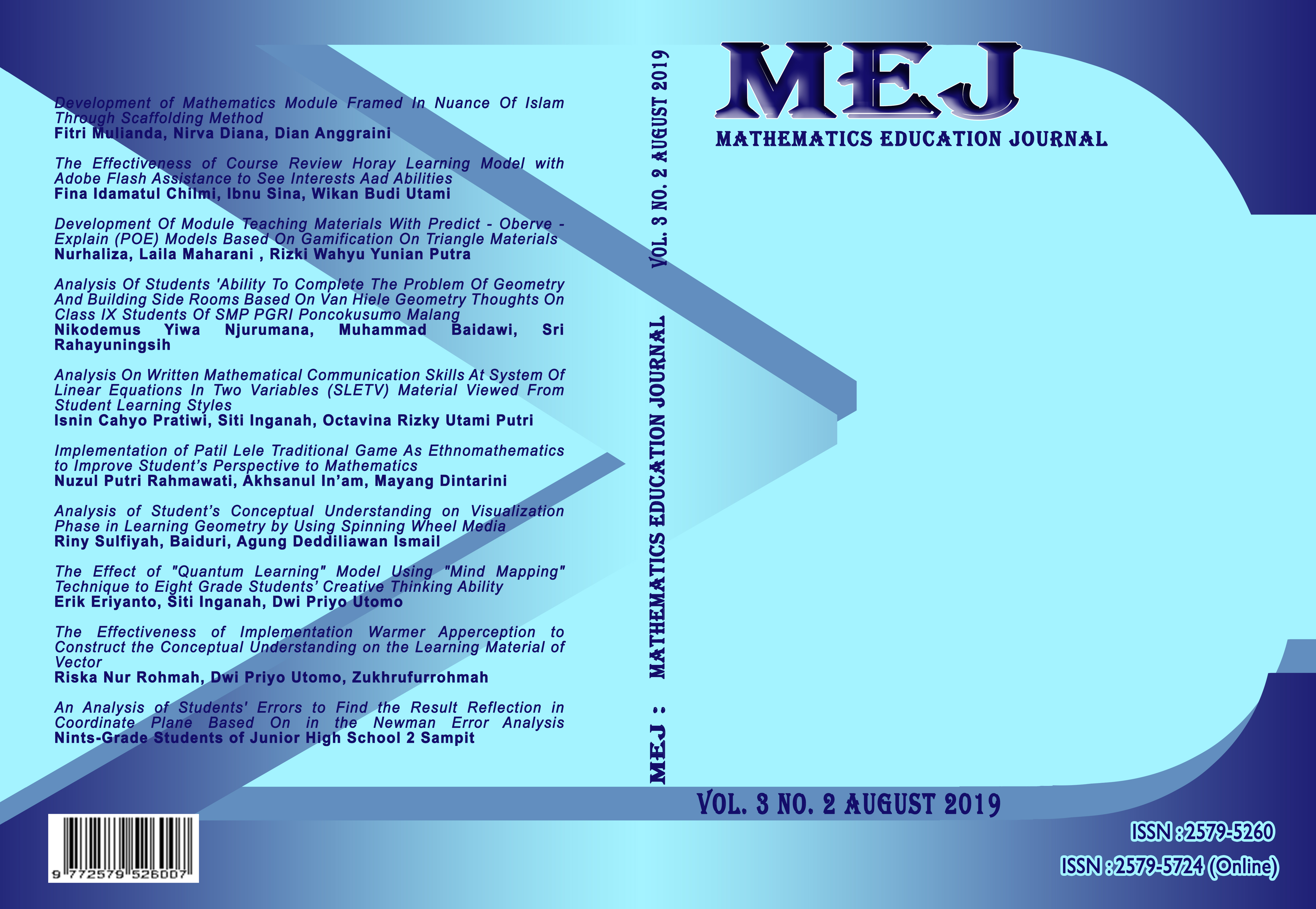Analysis Of Students 'Ability To Complete The Problem Of Geometry And Building Side Rooms Based On Van Hiele Geometry Thoughts On Class IX Students Of SMP PGRI Poncokusumo Malang
DOI:
https://doi.org/10.22219/mej.v3i2.11068Keywords:
build curved side spaces, level thinking Van HieleAbstract
The purpose of this study was to describe the ability of students' level of thinking insolving geometry problems with curved side spaces based on Van Hiele's level ofgeometry thinking in class IX students of SMP PGRI Poncokusumo Malang.
This research method is descriptive qualitative research. In this case the analysis of the description of the level of thinking of students in solving geometry problems arising from the curved side space based on Van Hiele's theory. The research subjects taken were grade IX students of Poncokusumo Middle School, totaling 11 students. The instruments used were test, interview and documentation instruments.
The results of the geometry problem analysis test show that the curvature shows that students have improved from previous studies where at level 0 and 1 all students have been able to achieve it, for level 2 there are 2 students who have not been able and level 3 there are 3 people who did not reach this level while for level 4 there are 5 students who are unable to achieve it. Researchers hope that the teacher who will teach the material to build curved side spaces to pay attention to methods that are suitable for students so that the student learning process does not experience complexity and pay attention to the process of working on problems and drawing conclusions. To increase the level of thinking students on geometry material, build curved side spaces can use teaching aids so that students easily understand.
Downloads
References
Abdussakir. (2010). Pembelajaran Geometri Sesuai Teori Van Hiele. Jurnal
Kependidikan dan Keagamaan,Vol VII Nomor 2, Januari 2010, ISSN 16931499.
Arend,
B.
(2009). Mendorong
Berpikir
Kritis
Dalam
Diskusi
Berulir
Online.
The
Journal
of
Ferdianto,
Ferry. (2010). Pembelajaran Geometri Berdasarkan Tahap Berpikir Van
Hiele. http://ferrymath.blogspot.com. Akses pada 21 Agustus 2017
Isoda, M., & Katagiri, S. (2012).Mathematical Thinking: How To Develop It In The
Classroom.Journal for Research in Mathematics Education. Vol. 15, No. 1, 8995.
Johnson, D. J, & Myklebust, H. R. (1967). Learning Disbilities, New York: Grume &
Stratton.Journal on Mathematics Education, 4(1), 75-94.Kreatif Mahasiswa
dalam Memecahkan dan Mengajukan Masalah Matematika.(Dissertation).
Kuswana, W. S. (2013). Taksonomi Berpikir. Bandung: PT Remaja Rosdakarya.
Lestariyani, Susi. (2013). Identifikasi Level Berpikir Geometri Siswa SMP Negeri 2
Ambarawa berdasarkan Teori Van Hiele.UKSW. Skripsi Tidak diterbitkan
Mega Teguh Budiarto. (2002). Bentuk kesalahan dalam menyelesaikan permasalahan
geometri.surabaya:pusat penelitian IKIP Surabaya.
Nur’aeni. (2008). TeoriVan Hiele Dan Komunikasi Matematika. Materi Semnas
Matematika Dan Pendidikan Matematika. PGSD UPI Kampus Tasikmalaya.
Rejeki, S. (2014).Pembelajaran Matematika dengan Pendekatan Teori Van Hiele untuk
Meningkatkan Keterampilan Dasar Geometri Siswa Kelas VII C SMP AlIrsyad
Surakarta
pada Materi
Segitiga.
Skripsi
UNS,
Surakarta
, 21-22.
Saragih, S. (2008). Mengembangkan Keterampilan Berfikir Matematika. Makalah
disajikan dalam Seminar Nasional Matematika dan Pendidikan Matematika,
Jurusan Pendidikan Matematika FMIPA UNY, Jogyakarta, 28 Desember 2008.
Sudarmanto. (2010). Tahap Berpikir Siswa BerdasarkanTeori van Hiele dalamBelajar
Geometri di KelasVII SMP Negeri 1 Sumber gempol Tulungagung Tahun
Ajaran 2011/2012Progam Studi Pendidikan MatematikaJurusan Tarbiyah,
STAIN Tulungagung
Sri Subarinah. (2006). Inovasi Pembelajaran Matematika SD. Jakarta: Depdiknas
Downloads
Published
Issue
Section
License
Authors who publish with MEJ (Mathematics Education Journal) agree to the following terms:
For all articles published in MEJ, copyright is retained by the authors. Authors give permission to the publisher to announce the work with conditions. When the manuscript is accepted for publication, the authors agree to automatic transfer of the publishing right to the publisher.
Authors retain copyright and grant the journal right of first publication with the work simultaneously licensed under a Creative Commons Attribution-ShareAlike 4.0 International License that allows others to share the work with an acknowledgment of the work's authorship and initial publication in this journal.
Authors are able to enter into separate, additional contractual arrangements for the non-exclusive distribution of the journal's published version of the work (e.g., post it to an institutional repository or publish it in a book), with an acknowledgment of its initial publication in this journal.
Authors are permitted and encouraged to post their work online (e.g., in institutional repositories or on their website) prior to and during the submission process, as it can lead to productive exchanges, as well as earlier and greater citation of published work (See The Effect of Open Access).

This work is licensed under a Creative Commons Attribution-ShareAlike 4.0 International License.










